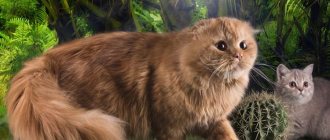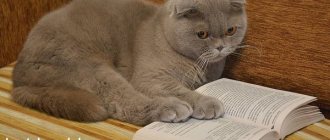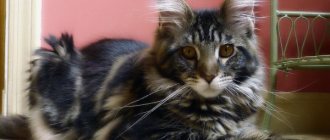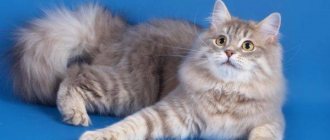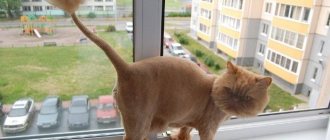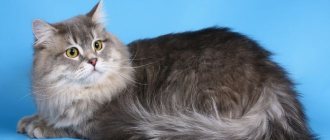The Scottish Straight cat breed is in the shadow of the Scottish Fold. Scottish cats are usually recognized by their funny “owl” head with folded ears. But few people know that it is unacceptable to breed a fold-eared cat with a fold-eared cat. The offspring from such parents will not be viable.
When they discovered a connection between osteochondrodysplasia and the main breed characteristic of the Scottish - funny ears, they wanted to ban the breed. But either enthusiasm or thirst for profit forced the breeders to find another solution. It was necessary to create a population of cats and cats that would carry all the characteristics of the Scottish breed, except for fold ears. This is how Scottish straights appeared.
Breeders breed fold-eared cats with straight-eared ones. Some kittens will be folds, some will be straights. And they will all be of Scottish breed.
The kitten in the center is a Scottish Straight, on the right and left are Scottish Fold kittens
Most buyers are targeting kittens with curled ears. But they also risk more - after all, along with lop ears, a cat can get a whole bag of diseases. First of all, deformation of bones and joints, a tendency to otitis media. Straight-eared Scots do not suffer from osteochondrodysplasia, but have a noble appearance and a pleasant character. I will tell you more about straights in this article.
Author of the article: Olga Shiltsova, practicing veterinarian, author of the books “Dachshund of Fate” and “Tails of Fortune”
History of the Scottish Straight cat breed
Scottish Straight cat
Scottish Straight are the same Scottish folds, but with a modified position of the ear. Straight ears do not have a characteristic crease and are set straight, and this, in fact, is the only external sign that distinguishes them from their fold-eared counterparts. Scottish cats are considered one of the youngest cat breeds. The first cat with an unusual, flattened ear shape appeared on a Scottish farm in the early 60s. Surprisingly, the ancestor of modern folds and straights had no pedigree and simply chased mice through the barns of local peasants.
The first official Scottish breeder was an ordinary villager, William Ross, who adopted a kitten from the aforementioned Fold. A few years later, professional breeders also joined the process. At the same time, experts witnessed an interesting phenomenon: in the litters brought by even the most purebred Scottish dogs, babies with erect ears appeared. Of course, no one intended to separate such individuals into a separate breed. And kilometer-long queues did not line up for straight-eared kittens, because against the backdrop of touching folds, they were outright losing. But here nature itself intervened.
Very soon, Scottish breeders noticed that attempts to strengthen and strengthen the lop ears of animals had a negative impact on their health. The mutated gene responsible for the flatness of the ear folds began to inhibit the function of the skeletal apparatus of cats. As a result, the Scots began to suffer from thickening of the bones and osteochondrodysplasia. To keep the breed afloat, breeders rushed to look for “new blood” that would help the Scottish survive and reduce the number of their genetic defects. Through trial, error and outcrossing, it was discovered that the healthiest and most beautiful offspring can be obtained from crossing a Fold cat and a straight-eared male of the same breed. It was thanks to this discovery that breeders and felinological associations finally turned their attention to straight-eared Scots. Well, in 2004, the Scottish Straight subspecies received official recognition from the World Cat Federation and the status of an independent breed, which sharply increased the attractiveness of straight-eared cats in the eyes of potential buyers.
Leisure influencing character
The character of Scottish straight-eared male cats is somewhat different from girls. Males more often show their hunting skills, strive to get their own food and show strength in the process of protecting themselves. Females are more affectionate and playful, but if they have offspring, they can show aggression.
In order for a kitten to develop harmoniously, it needs a variety of toys. If there are a lot of them, then the pet is unlikely to turn into a glutton, a calm phlegmatic person or a lump. Such a Scot will be characterized by agility, energy and a desire to hunt.
Appearance of the Scottish Straight
Scottish Straights can easily be confused with the British, although representatives of these two breeds have a minimum of common genes. Scottish Straight cats are much smaller than their competitors from Albion, although they have a longer body. The weight of an average straight is 3-3.5 kg. Modern breeders are still wondering what kind of offspring they will get after mating a fold and a straight, since initially all kittens are born with ordinary ears, which change their position only at the end of the first month of life.
Head
Mustachioed Scotsman
According to the WCF standard, Scottish Straights must have a rounded skull. Representatives of this breed have convex foreheads and cheeks. In cats, the area of the cheekbones and cheeks is noticeably more rounded than in cats. The chin of the Scots is firm, rounded, but does not protrude forward. The whisker pads are distinguished by their characteristic “swelling” and have the shape of a regular oval.
Nose
Wide and short, with a slight arch of the back and a pronounced base, practically without a stop.
Eyes
Large and round, widely spaced. The gaze is open, inquisitively focused. Eye color depends on the coat color of the animal.
Ears
Erect, small, with a wide base. The tips of the ears are rounded and point forward. The outer part of the ear is covered with thick, close-fitting hair. The inner part is decorated with lush and stiff hair brushes extending beyond the edge of the ear.
Neck
The Scottish Straight cat has a muscular and short neck.
Scottish Straight muzzle
Frame
Moderately long, muscular and wide, tending to the rectangular type. The silhouette line is soft and rounded.
Limbs
Proportional to the body, that is, moderately long and strong, with developed muscles. The paws are oval, the toes are tightly clenched.
Tail
Medium or long, mobile, reaching to the middle of the shoulder blades.
Wool
Scottish Straight tabby color
Short or semi-long (in Highland individuals). Double, plush type, with well-developed undercoat. It does not adhere to the body, but covers it tightly. The texture of the coat may vary slightly depending on the season, as well as the type of color of the animal.
Color
The standard allows all types of colors found among representatives of this breed. The most typical color options for Scottish Straight cats are solid, bicolor, point, tabby, particolor, chinchilla, ticked, van and shedded.
Defects in appearance and disqualifying defects
Individuals with semi-erect or too wide ears with a British set are considered not the most successful representatives of their breed. The flat forehead, pronounced stop, long legs and small eyes of the Scottish Straight are also not decorative. Animals with an insufficiently long, inactive and kinked tail, cryptorchidism and everted toes are subject to unconditional disqualification. Weak and sick cats are also not allowed to participate in exhibition events.
Kittens from a Scottish Fold cat, with an average of five straight-eared and one fold-eared
How the breed appeared
We already know from the name where such cats came from - from Scotland. This breed was obtained by crossing with the Scottish Fold.
Drooping ears became a recessive trait several centuries ago, which contributed to
creation of a separate Scottish Straight breed. This genetic trait sometimes appears across generations. It is interesting that initially a kitten may have droopy ears, while another purebred representative will have straight ears soon after birth.
Scottish Straight character
It would be a big mistake to label all Scottish Straights as phlegmatic philosophers. Moreover, among these imposing cats, sometimes there are real livelies who love to chase a wind-up mouse and measure their strength with the owner. And yet, for the most part, Scottish straight cats do not have a violent temperament. Proud and serious, they cannot stand total control and are unlikely to allow themselves to be squeezed into a semi-conscious state. This, of course, does not make Scottish ascetics and sad hermits, they just require a little more independence and personal space than representatives of other breeds. Straights prefer to spend their free time in peace and quiet, lounging on the couch and learning Zen in the Buddha pose.
Squeezing the cat
The Scots are happy to make contact and join in the games, but only when they want to. In all other cases, it is better to leave the cat alone. The peak of motor activity of straight-eared Scottish cats occurs in the first year of their life. By the way, Scottish babies in their playfulness and restlessness are practically no different from ordinary outbred kittens. Adults, on the contrary, are famous for their exemplary behavior and patience. If you go on a visit for a couple of hours, leaving the Straight alone, he will easily survive it. However, weeks of loneliness, interrupted by rare raids from the owner, will not improve the character of the animal. As for the pacifying purr of straight-eared Scottish cats, it still needs to be earned: cats purr infrequently, and meow only in exceptional, from their own point of view, cases. Scottish Straights accept strangers and noisy groups of guests in a completely “secular” way, which means without unnecessary suspicion and aggression, but also without wild delight.
Scottish Straight cats are emotionally stable and not subject to sudden mood swings. However, exceptions to the general rule have not been canceled, so amateur videos with catchy headlines like: “The most disgruntled Scottish in the world” periodically appear on the Internet. In addition, straights are characterized by amazing persistence. If a cat wants something, he will definitely achieve it, following on the heels of the owner, and sometimes reinforcing his actions with annoying meows.
Balanced and calm family member
If you need to get a non-capricious and balanced kitten who will not constantly jump and regularly demand attention, you need to take a closer look at the babies who sit apart in the basket. Usually such kids do not participate in the fun of others, and if they are drawn into the game, then the kittens join in without much enthusiasm.
Balanced kids love to sleep and spend a lot of time alone. If they begin to explore the surrounding space, they do it alone.
There is even a pattern by which you can identify a calm, straight-eared Scottish cat. The character and habits of such a baby will be distinguished by calmness and balance in its external and internal manifestations. The kitten carefully touches various objects with its paw, does not strive to constantly be the center of attention and does not involve other pets in its explorations.
Such an animal gets very used to its owners and becomes a family favorite. Usually these cats are immersed in themselves and try to somewhat isolate themselves from others.
Training and education
Scottish Straight
Intelligent by nature, Scottish Straight cats are easy to educate and very difficult to fully train. Teaching a Straight to use a litter box and a scratching post is not at all difficult, provided that this process was started in time, before your pet matures. By the way, young Scottish cats are active and sometimes uncontrollable, so in the first months of the baby’s life you will have to put up with the inevitable destruction in the house.
Even if the fame of Yuri Kuklachev haunts you, it’s better not to get carried away with the serious drill of straights. Whatever the experts say, unquestioning obedience to commands is not the strong point of Scottish straight-eared cats. Instill in your pet the basics of etiquette and teach him to respect subordination - this will be quite enough. As for a full-fledged training program, save it for show-class individuals, who will later have to demonstrate their talents at exhibitions.
- If the animal allows itself too much, try to stop it with the command “No!”, which is given in a stern and loud voice.
- If the kitten does not respond to a stern tone, grab it by the scruff of the neck and imitate a cat hissing. The baby will understand this language faster.
- Do not try to poke the kitten's muzzle into the puddle it has made or try to hammer the basics of cleanliness into it with a slipper. After suffering stress, the cat will definitely play a mischief in another place, but this time it will be reliably hidden from you.
- Have you noticed that your plush beast is sitting in an unambiguous position on the carpet or trying to steal food from the table? Scare him with a loud whistle or clap of your hands. Make no mistake, fear is a very powerful educational tool.
- Never scold or praise a Scottish Straight cat after the fact. Despite a fairly high level of intelligence, the animal is not able to connect together yesterday's exemplary behavior and today's reward.
Presence of other animals in the family
Scottish Straights often look down on other pets. However, if they were brought up with such people from childhood, then such an attitude does not arise. When a kitten ends up in a home inhabited by other animals, the owners can rest assured of a positive outcome. The baby will definitely get along not only with his relatives, but also with birds, tame rodents and even dogs.
The character of the Scottish straight-eared cat, who grew up in the same house with dogs, is distinguished by mischief and cheerfulness. These animals are cheerful, agile and very attached to their owner.
But living in the same house with felines, the Scots can become overly jealous. In this case, they become attached to cats more than to members of the household and the owner.
Care and maintenance
Scottish Straights are typical domestic cats for whom walks in the fresh air are pleasant entertainment, but not more than that. This is why Scots are considered ideal pets for homebodies. In everyday life, straights are unpretentious and rarely cause trouble. Take your animal for routine veterinary examinations, carry out timely vaccinations, use high-quality food - and straight-eared Scottish cats will not create any problems for you.
Hygiene
Scottish Straight loves his mistress
Scottish Straights are very clean cats that carefully monitor the condition of their own fur, but they still need to be bathed from time to time. Usually, cats are washed as their “coat” gets dirty, using shampoo from the pharmacy. At the end of the procedure, you can apply a balm to the coat. When bathing, make sure that water does not get into the animal’s ears and be sure to protect the wet pet from drafts.
Owners of show-class specimens preparing to participate in exhibitions will have to work a little harder. In particular, a few months before the event, the cat begins to be washed daily to completely remove dead cells from its skin and stimulate the growth of new fur. In addition, you will have to spend money on a variety of professional coat care products, ranging from degreasing paste to texturizing conditioner. Brush Scottish cats once a week with a short hair brush. Claws are trimmed as they grow. Be sure to monitor the condition of your cat's eyes and remove unwanted discharge with a swab soaked in hygiene lotion.
Feeding
The diet of Scottish Straights is no different from the “menu” of their fold-eared counterparts. Just like folds, Scottish straight-eared cats benefit from lean meat, offal, boiled sea fish, fermented milk products, and egg yolk. In addition, the animal’s diet should include vegetables (raw or stewed), cereals and sprouted wheat.
Prohibited
- Fat meat.
- Beans and potatoes.
- Bones.
- Sweets, spices, smoked foods.
- Garlic and onion.
- Bread.
- River fish.
- Citrus.
- Mushrooms.
- Raw eggs.
Curious Scottish Straight
In serious nurseries, Scottish Straight kittens are sold starting from the age of three months. During this period of life, the baby no longer feeds on mother's milk, which means it is able to eat the same food as an adult animal.
An important point: natural-fed straight cats do not receive enough of the vital microelements. Vitamin and mineral complexes, which can be purchased at a veterinary pharmacy, solve this problem.
Scottish Fold cats can also be fed commercial food if you are willing to spend money on its non-budget varieties - “premium”, “super premium” and “holistic”. An ideal cut for a Scottish dog should contain at least 26% protein and about 9% fat. It is advisable that the food does not contain wheat and corn, which can cause allergies in the cat. From this point of view, the most useful options for “drying” can be considered the Canadian Acana Pacifica Cat and the American Earthborn Holistic.
Three-month-old Scots are fed up to 6 times a day, six-month-old kittens eat 5 times a day, nine-month-old kittens - 4 times. One-year-old individuals are considered adults, so 2-3 meals are enough for them.
Health and disease of the Scottish Straight cat
Scots live up to 15-20 years of age without much difficulty, but only if they were properly cared for and mandatory veterinary procedures were not neglected. Unlike folds, straights have practically no genetic mutations or hereditary diseases, so representatives of this breed are relatively healthy animals with good immunity. As for diseases of the gastrointestinal tract and genitourinary system, sometimes diagnosed in straight-eared Scottish cats, they are most often caused by poor nutrition.
The Scot as a true friend
Many people want to get a representative of this breed because the animals are obedient. For your pet to understand that they are angry with him, it is enough to change his intonation. Reviews from breeders show that it is quite easy to train small kittens to use a tray. If necessary, they can relieve their needs in the courtyard of a private house. Scottish Straight cats quickly learn what is permissible to do in the house and what will be punished. Many Scottish owners say that it is not scary to leave such a pet at home alone, because it does not harm property. Often breeders find an animal in the same place where it lay before they left.
However, this does not mean that the animal is inactive. Scottish Straight cats are very inquisitive and playful. Animals often do not know how to stop when participating in games, so it is worth limiting pets in their natural instincts and not allowing them to scratch themselves or household things.
How to choose a Scottish Straight kitten
Arm yourself with the breed standard and visit a Scottish Straight breeder in an informal setting to see with your own eyes the conditions in which the kittens grow up. Well-groomed Scottish dogs have lush, shiny coats and clear, open eyes. The abdomen of a normally developing baby is soft, and not swollen to the point of a ball. A healthy kitten's tail should be clean, and its fur should not smell bad or sparkle with bald spots.
Observe the behavior of the young Scottish Straight. A trouble-free baby willingly joins in the gameplay and shows interest. Kittens that are bored and unresponsive are most likely unhealthy or depressed. Observing the character of the babies’ parents is also a good safety net, since it is from them that the animals inherit their temperamental characteristics.
Some confusion
The Scottish Straight cat, the photo of which is presented in this article, is a close relative of the Scottish Straight. However, the characters of the animals are radically different. Often the habits of the latter cause bewilderment among breeders; they cannot be kept in a family with children due to excessive aggressiveness and intolerance even with small pranks.
The characteristics of Scottish straight-eared cats are radically different. They are completely different from their relatives. However, before purchasing them, it is necessary to find out the characteristics of the animal’s character and its standard habits, so that if difficulties arise in upbringing, you will be able to cope with them.
